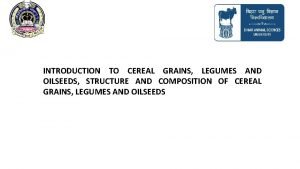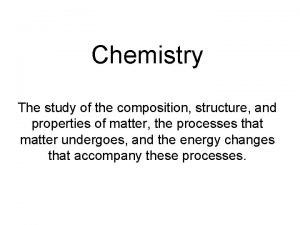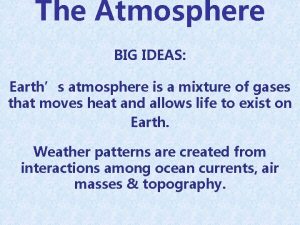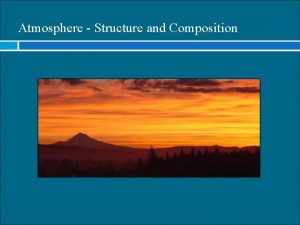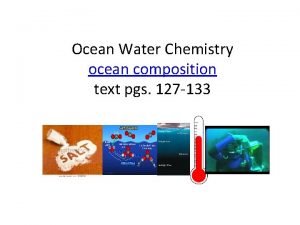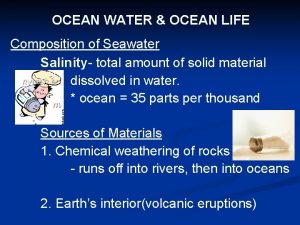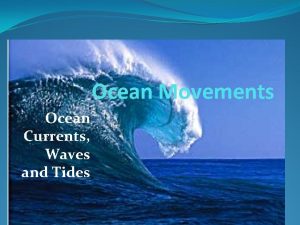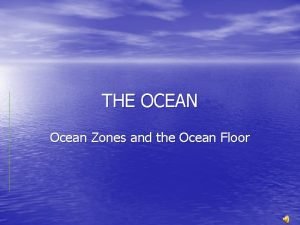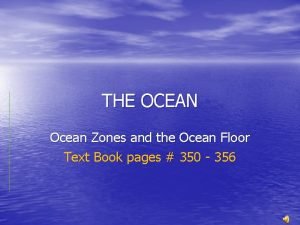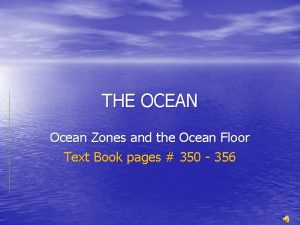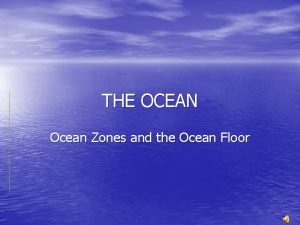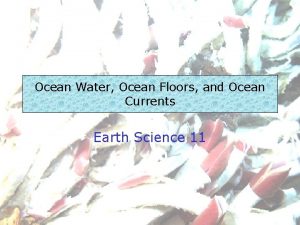Ocean structure and composition The Ocean in action





















- Slides: 21

Ocean structure and composition

The Ocean in action • The ocean is a continuous body of salty water that covers two-thirds of our planet. Five main regions of the ocean have been given the names Pacific, Atlantic, Indian, Arctic and Southern Oceans. There also smaller areas called seas. Some of these are part of a larger ocean – for example, the Tasman Sea between New Zealand Australia is part of the Pacific Ocean. Other seas are almost surrounded by land but are still connected to an ocean – an example is the Mediterranean Sea, which is connected to the Atlantic Ocean only by a small gap between Europe and Africa.


Seawater properties • Saltiness (scientists call this saltiness ‘salinity’) and density are just two properties of seawater that affect many aspects of life on Earth. • Salinity is a measure of the saltiness of seawater. It is caused mostly by the chemical sodium chloride. Salinity is an important property – salt makes seawater denser than freshwater. • The ocean is not the same everywhere. Seawater properties vary from place to place – for example, some parts of the ocean are more or less salty, warmer or cooler, more or less dense. Properties also change over time, from season to season and year to year, as well as over much longer timescales.

Why is the ocean salty? • Salt in the ocean comes from rocks on land. • The rain that falls on the land contains some dissolved carbon dioxide from the surrounding air. This causes the rainwater to be slightly acidic due to carbonic acid (which forms from carbon dioxide and water). • As the rain erodes the rock, acids in the rainwater break down the rock. This process creates ions, or electrically charged atomic particles. These ions are carried away in runoff to streams and rivers and, ultimately, to the ocean. Many of the dissolved ions are used by organisms in the ocean and are removed from the water. Others are not used up and are left for long periods of time where their concentrations increase over time.

• Two of the most prevalant ions in seawater are chloride and sodium. Together, they make up over 90 percent of all dissolved ions in the ocean. Sodium and Chloride are 'salty. ' • The concentration of salt in seawater (salinity) is about 35 parts per thousand, on average. Stated in another way, about 3. 5 percent of the weight of seawater comes from the dissolved salts. • By some estimates, if the salt in the ocean could be removed and spread evenly over the Earth’s land surface it would form a layer more than 500 feet thick, about the height of a 40 -story office building.


• Like the atmosphere, the oceans are not uniformly mixed but are structured in layers with distinct properties. Pressure increases with depth as the weight of the overlying air and water increase. Unlike the atmosphere, however, pressure changes at a linear rate rather than exponentially because water is almost impossible to compress, so its mass is equally distributed throughout a vertical water column. Atmospheric pressure at sea level is 14. 7 pounds per square inch (also referred to as "one atmosphere"), and pressure increases by an additional atmosphere for every 10 meters of descent under water. This gradient is well known to scuba divers who have experienced painful "ear squeeze" from pressure differences between the air in their ears and the seawater around them. • Ocean layers

Ocean structure and composition • Except at high latitudes, the ocean is divided into three horizontal depth zones based on density: 1. the mixed layer 2. Pycnocline 3. deep layer • At high latitudes, the pycnocline and mixed layer are absent. Layers, saltiness and density • Summarise each of the layers from the following slides


• Wind-driven surface currents are restricted mostly to the ocean's uppermost 100 m (300 ft) layer or so depending upon the depth of the pycnocline. This is because thickness of the surface mixed layer is typically 100 m or less. The pycnocline acts as a porous boundary that allows some kinetic energy to penetrate into deep water. The strongest currents generally occur in the ocean's surface layer although some surface currents such as boundary currents like the Gulf Stream can be relatively strong to depths of several hundred meters. Surface currents are changeable, continually responding to variations in the wind, precipitation, and heating or cooling. Stirring of surface waters by the wind produces a well-mixed layer of uniform or nearly uniform density. For this reason, the ocean surface is called the mixed layer. We know most about the mixed layer because ships, aircraft, and Earth-orbiting satellites can readily monitor it.

• The pycnocline, situated between the mixed layer and the deep layer, is where water density increases rapidly with depth because of changes in temperature and/or salinity. Recall that cold water is denser than warm water and salty water is denser than fresh water. Where a decline in temperature with depth is responsible for the increase in density with depth, the pycnocline is also a thermocline. On the other hand, if an increase in salinity is responsible for the increase in density with depth, the pycnocline is also a halocline. Typically, the pycnocline extends to a depth of 500 to 1000 m (1600 to 3300 ft). (However, in middle latitudes seasonal pycnoclines may develop within the mixed layer. ) The dark, cold deep layer below the pycnocline accounts for most of the ocean's mass. Within the deep layer, density increases gradually with depth and water moves slowly; in only a few locations (usually near the bottom) are water movements fast enough to be considered currents

• The ocean's three-layer structure is an example of how gravity separates a fluid into layers such that the density of each layer is less than the density of the layer below it. More dense fluids sink and less dense fluids rise. The ocean's pycnocline is very stable thus suppressing mixing between the mixed layer and deep layer; that is, the pycnocline acts as a barrier to vertical motion within the ocean. The concept of stability is useful in understanding this property of the pycnocline.

• Stability as used here refers to vertical motions of ocean water. A system is described as stable if it tends to persist in its original state without changing. Following a disturbance (i. e. , vertical motion), a stable system returns to its initial state or condition. As noted above, the usual stable state of the ocean features a layer of water that is warmest near its interface with the atmosphere (the mixed layer) and the mixed layer overlies water that becomes denser with increasing depth (the pycnocline). Strong storm winds may temporarily disturb this stable stratification bringing colder than usual water to the surface. Once the wind slackens, however, the original layered structure is soon restored.


The Zones • The Epipelagic, or sunlight, zone (so called because most visible light in the oceans is found here) comprises the first 200 meters below the surface, and is warm and mixed by winds and wave action. Surface waters account for about 2 percent of total worldwide ocean volume. At a depth of about 200 meters, the Continental Shelf (the submerged border of the continents) begins to slope more sharply downward, marking the start of the Mesopelagic, or twilight, zone. Here water temperature falls rapidly with depth to less than 5°C at 1, 000 meters. This sharp transition, which is called thermocline, inhibits vertical mixing between denser, colder water at depths and warmer water nearer the surface. About 18 percent of the total volume of the oceans is within this zone.


• Below 1, 000 meters, in the Bathypelagic, or midnight, zone, water is almost uniformly cold, approximately 4°C. No sunlight penetrates to this level, and pressure at the bottom of the zone (around 4, 000 meters depth) is about 5, 880 pounds per square inch. Little life exists at the Abyssopelagic (abyssal) zone, which reaches to the ocean floor at a depth of about 6, 000 meters. Together, these cold, deep layers contain about 80 percent of the total volume of the ocean.

• The deepest points in the ocean lie in long, narrow trenches that occur at convergence zones—points where two oceanic plates collide and one is driven beneath the other. This region is called the Hadal zone. The deepest oceanic trench measured to date is the Marianas Trench near the Philippines, which reaches more than 10, 000 meters below sea level. Highly specialized life forms, including fish, shrimps, sea cucumbers, and microbes, survive even at these depths.

• Movement along colliding plates in convergence zones frequently generates earthquakes and tsunamis; an earthquake measuring 9. 15 on the Richter scale off the coast of Sumatra triggered the Indian Ocean tsunami that killed more than 230, 000 people on December 26, 2004. Volcanoes often erupt near convergence zones when hot magma escapes through rock fractures. Many of the world's largest ocean trenches, therefore, are located along the "Ring of Fire, " an arc of volcanoes around the Pacific Ocean that denotes convergent plates margins.

 Chapter 15 ocean water and ocean life
Chapter 15 ocean water and ocean life Divergent convergent and transform
Divergent convergent and transform Ocean ocean convergent boundary
Ocean ocean convergent boundary Convergent plate boundaries
Convergent plate boundaries Ocean ocean convergent boundary
Ocean ocean convergent boundary Ice age scrat underwater
Ice age scrat underwater Convergent oceanic oceanic plate boundary
Convergent oceanic oceanic plate boundary Blue og red ocean
Blue og red ocean Structure of cereals
Structure of cereals Study of composition structure and properties
Study of composition structure and properties Draw and label the composition of the egg
Draw and label the composition of the egg Explain composition and structure of atmosphere
Explain composition and structure of atmosphere Four action framework of blue ocean strategy
Four action framework of blue ocean strategy Hình ảnh bộ gõ cơ thể búng tay
Hình ảnh bộ gõ cơ thể búng tay Lp html
Lp html Bổ thể
Bổ thể Tỉ lệ cơ thể trẻ em
Tỉ lệ cơ thể trẻ em Voi kéo gỗ như thế nào
Voi kéo gỗ như thế nào Glasgow thang điểm
Glasgow thang điểm Chúa yêu trần thế alleluia
Chúa yêu trần thế alleluia Môn thể thao bắt đầu bằng từ chạy
Môn thể thao bắt đầu bằng từ chạy Thế nào là hệ số cao nhất
Thế nào là hệ số cao nhất








